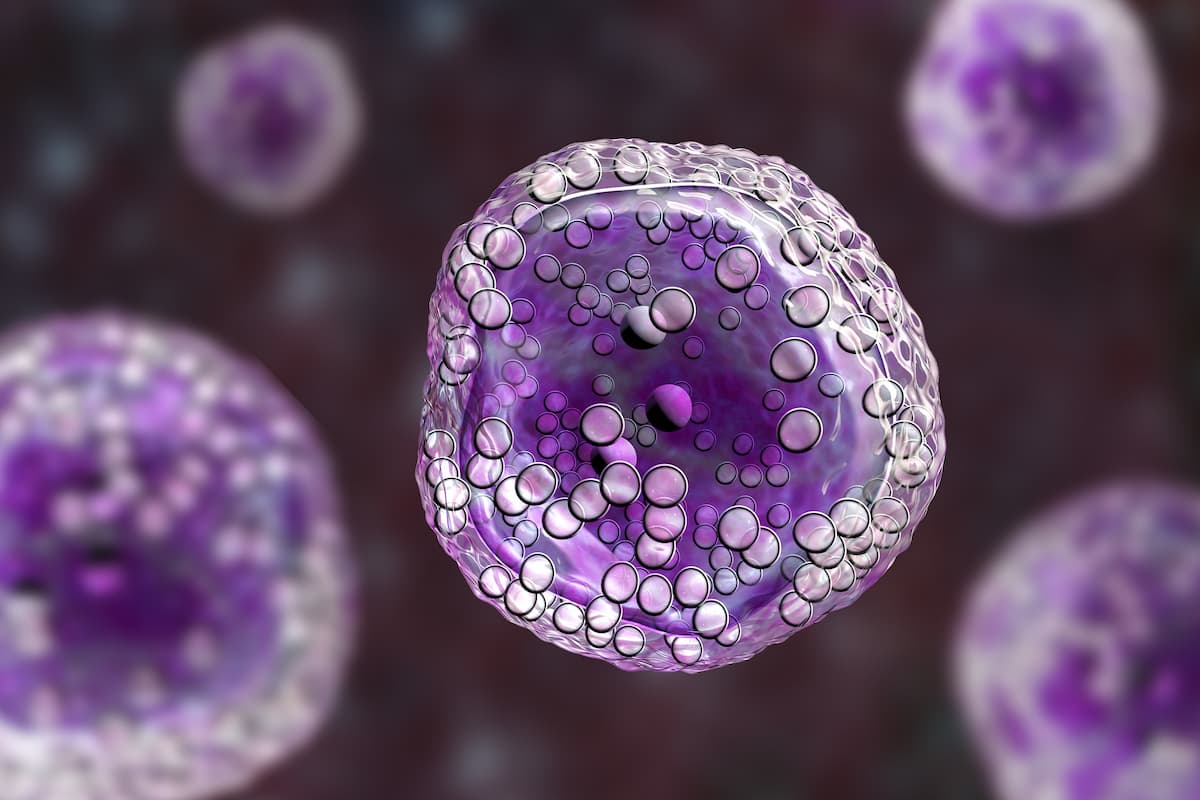Once-Weekly Doses of Carfilzomib Show Balanced Benefit in Real-World RRMM
A real-world analysis showed that 56 mg/m2 of carfilzomib once weekly offered many benefits over 56 mg/m2 twice weekly and 70 mg/m2 once weekly in myeloma.
Once weekly 56 mg/m2 doses of carfilzomib demonstrated benefits over 56 mg/m2 twice weekly and 70 mg/m2 once weekly in multiple myeloma in a real-world setting.

A dose of 56 mg/m2 of carfilzomib (Kyprolis) once weekly may demonstrate the best balance of efficacy, safety, and avoidance of time toxicity from frequent infusions in the treatment of patients with relapsed or refractory multiple myeloma, according to findings from a real-world analysis published in Blood Cancer Journal.
The median real-world progression-free survival (PFS) was 12.98 months (95% CI, 11.17-20.70) for patients who received 56 mg/m2 of carfilzomib once weekly, 13.17 months (95% CI, 8.97-28.09) for those who received 56 mg/m2 twice weekly, and 10.94 months (95% CI, 9.92-15.28) for those who received 70 mg/m2 once weekly; these differences were not statistically significant (P = .46).
The median real-world overall survival (OS) was 44.55 months (95% CI, 30.23-not reached [NR]) with 56 mg/m2 once weekly, 49.05 months (95% CI, 38.14-NR) with 56 mg/m2 twice weekly, and 39.16 months (95% CI, 29.60-50.99) with 70 mg/m2 once weekly; these values were not considered statistically significant (P = .62).
“Our findings suggest that higher doses or more frequent dosing of carfilzomib beyond [56 mg/m2 once weekly] are not associated with better clinical outcomes in the real-world setting,” senior study author Gurbakhash Kaur, MD, an assistant professor of Medicine, Hematology, and Medical Oncology at Mount Sinai School of Medicine, New York, NY, and fellow authors stated in the paper. “Similarly, adopting [56 mg/m2 once weekly] in trials and guidelines may reduce disparities in the treatment of relapsed/refractory [multiple myeloma].”
A total of 17,694 patients who were treated for relapsed or refractory multiple myeloma were recorded in the Flatiron Health database, of whom 2420 patients received any type of carfilzomib-containing regimen; 20.1% (n = 486) of these patients received carfilzomib at 56 mg/m2 once weekly (n = 136), 56 mg/m2 twice weekly (n = 86), and 70 mg/m2 once weekly (n = 264). The agent was received in a second-line setting for 41.6% of patients and in later-line settings for 58.4%.
Patients between 18 and 70 years old who were diagnosed with relapsed or refractory multiple myeloma between July 2012 and June 2023 and treated with a carfilzomib-containing regimen in a second-line or greater setting were included.
The median age of patients was 68 years (IQR, 61-75) at the time of treatment initiation; 55.1% of patients were male; and 54.9% were non-Latinx White. Additionally, 73.7% received treatment in a community center, 19.1% at an academic practice, and 7.2% at both; 55.3% had Medicare, and 14.4% had commercial insurance; and 42.0% had an ECOG performance status of 1.
The primary end points of the analysis were real-world PFS and real-world OS.
Regarding prescribing trends, 57.0% of patients received carfilzomib as part of a triplet regimen; CD38 monoclonal antibodies with carfilzomib and dexamethasone were used in 30.7% of patients, and immunomodulatory drugs with carfilzomib and dexamethasone were used in 18.1%.
Those who received carfilzomib at 56 mg/m2 twice weekly were more likely to receive the agent in a doublet with dexamethasone, as it occurred in 46.5% of patients; only 4.7% of patients received a quadruplet regimen for relapsed/refractory multiple myeloma. Of patients who received carfilzomib at 56 mg/m2 once weekly, 15.4% received it as a doublet with dexamethasone, and 19.1% received it in a quadruplet regimen. The carfilzomib at 70 mg/m2 once weekly dosing schedule was given as a doublet regimen with dexamethasone in 20.1% of patients and as a quadruplet in 7.2%.
In 2023, 50.6% of patients were administered carfilzomib at 70 mg/m2 once weekly whereas 37.0% received it at 56 mg/m2 once weekly and 12.3% received it at 56 mg/m2 twice weekly.
Regarding safety, hypertension was found in 5.8% to 13.2% of patients across all prescribing patterns; the average prevalence was 9.9%. Congestive heart failure was found in 0.0% to 4.4%; all 12 cases were split between the 56 mg/m2 once weekly group (n = 6; 4.4%) and the 70 mg/m2 once weekly group (n = 6; 2.3%). Overall, acute kidney injury occurred in 4.1% of patients, primarily the 56 mg/m2 once weekly (n = 9) and the 70 mg/m2 once weekly groups (n = 10). Pulmonary hypertension was detected in 1.0% (n = 5) of patients, with the majority in the 56 mg/m2 once weekly group (n = 3; 2.2%). The differences in adverse events were not statistically significant.
Reference
Dong S, Banerjee R, Khan AM, et al. Carfilzomib prescribing patterns and outcomes for relapsed or refractory multiple myeloma: a real-world analysis. Blood Cancer J. 2025;15(1):48. doi:10.1038/s41408-025-01256-2
Navigating AE Management for Cellular Therapy Across Hematologic Cancers
A panel of clinical pharmacists discussed strategies for mitigating toxicities across different multiple myeloma, lymphoma, and leukemia populations.